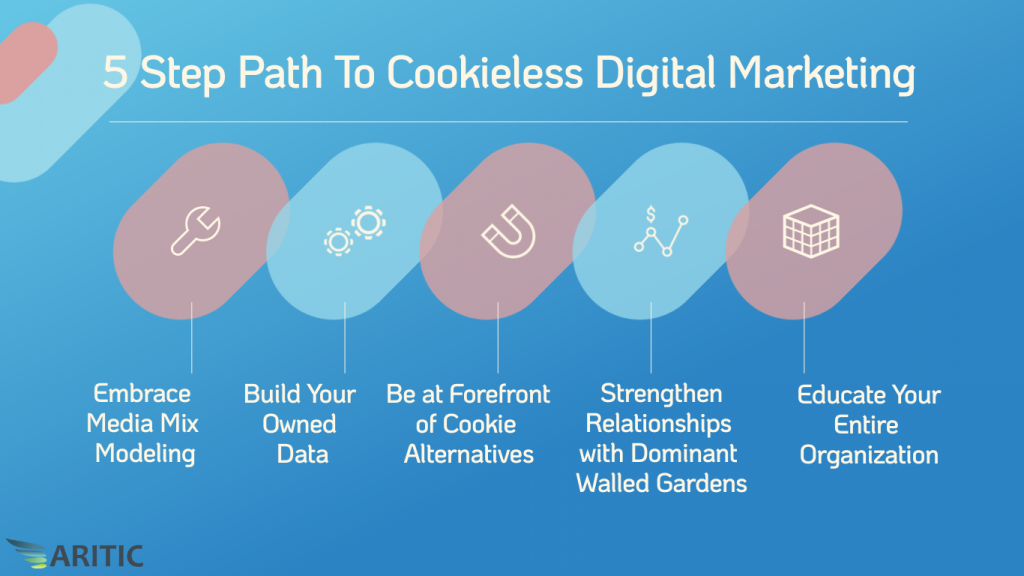In January 2020, Google announced that it plans to end support for third-party cookies in its Chrome browser, sharing 63.54% browser market share worldwide, within two years.
Third-party cookies are known to fuel the majority portion of the digital marketing ecosystem, and phasing out these will lead to alternative technologies governing the cookieless future.
Jump Directly to
1 . 1st, 2nd & 3rd Party Cookies
2. How Marketers Can Prepare for a Cookieless Future
3. A 5-step path to cookieless digital marketing
Cookies, prominently called HTTP cookies, are little packets of data stored as text files on a web browser. Cookies were invented in 1994 by Lou Montulli, who is well known for co-authoring a text-based web browser called Lynx.
Cookies came into existence to make websites commercially viable, identify people, remember their specific characteristics, and shoot away from the difficulties like tracking new vs. frequent visitors.
Still Not an User of Aritic PinPoint Automation?
Cookie introduction led to a fundamental shift in the web’s history. It entirely changed the web from a space of discontinuous visits into an information-rich environment. It tracks user activity, remembers web configuration, log-in details, IP addresses, search history, and more.
Cookies brightened up the way we browse the web today and have established an environment of rich user experience while helping advertisers to scale their methods to target prospective customers based on their cookie preferences. Various types of cookies play into the web field today. Let’s take a look at basic types of cookies to understand them with a better perspective.
1st, 2nd & 3rd Party Cookies
First-Party Cookies
First-party cookies are cookies generated from the primary domain of the website visited by a user. Users are prompted for consent by the domain or website to allow cookies. The website stores cookies from your browsing session and specifically collects analytics data, remember language preferences, and other useful data to provide a seamless user experience.
Second-Party Cookies
Second-party Cookies are cookies essentially containing first-party cookies. These first-party cookies are segmented, bundled, and transferred from one organization to another via direct partnerships. Consider it like the data that a user hasn’t directly shared with you, but you acquire this highly accurate and safe data through partnership.
Third-Party Cookies
Third-party cookies do not originate from the primary domain that a user visits. Instead, these cookies are created and stored by organizations other than the one user is visiting- advertising networks, analytics services, or tracking solutions providers. These cookies often are used for cross-site ad tracking, audience profiling, ad personalization, and retargeting.
Impact on advertising
Digital advertising relies heavily on third-party cookies for various purposes such as retargeting, conversion tracking, hyper-personalization, etc., to drive programmatic advertising. Third-party cookies are like back-bone for them to showcase their advertising core capabilities.
The scrapping of third-party cookies would mean a large chunk of third-party audiences will obliviate or shrink in size due to cookie expiration. Media bidding activities will have to re-energize for remaining sufficiently scalable post this significant change as cookieless advertising will become prominent in the cookieless future.
Besides all this, advertisers will need to innovate new methods and create new strategies that will not rely on third-party cookies to carry out activities such as prospecting, collecting audience data, and aggregating audience data.
How Marketers Can Prepare for a Cookieless Future?
Marketers had been using cookies since their genesis back in 1994. Cookies are a critical tool in understanding prospect behavior and devising a strategy to target them effectively. As concerns about privacy and security are a central point now post GDPR, cookies will soon bid adieu.
By the year 2022, third-party cookies will be exterminated. Besides this, several data restrictions on privacy concerns and regulations will also come into the picture. With most digital advertising platforms feeding on cookies for tracking and targeting, things will turn harder in the cookieless future. They will have to rely on better strategies for being prepared for cookieless tracking. There’s no better time than now to prepare and devise new advertising strategies and tactics for cookieless future.
The perfect time to focus on alternative strategies to target your prospects is now. Instead of thinking of this change as a bad omen, think of it as another big opportunity. Here is a 5-step path to cookieless digital marketing that brings alternative strategies that you can do:
A 5-step path to cookieless digital marketing

1. Embrace media mix modeling
Media Mix Modeling provides in-depth insights into specific marketing tactics over an extended period. Media mix modeling lets dealing with historical data to analyze patterns in campaign effectiveness. It enables marketers to comprehend better trends such as seasonality, holidays, brand equity, etc.
Suppose marketers want to leverage media mix modeling in the cookieless future successfully. In that case, they need to develop confidence in the metrics provided by dominant walled gardens of the web – Facebook, Google, and Amazon. Their massive logged-in audience base and lucrative first-party data will position them as cemented entities on the future media plan in the cookieless future.
2. Build Your Owned Data
While third-party cookies will slowly die, first-party cookies will stay. A strategic, precise, and thorough implementation of data capturing methods will ensure valuable data is available as granular units for prospecting, targeting, and hyper-personalization based on user’s engagement behaviors with your brand.
It may be an apt time to begin capturing opt-in emails and enriching your owned database directly. Your owned data or first-party data will prove to be the biggest asset for you in the cookieless future, and it will only increase in value. Still, you may need to spend more time building up your data volumes and amplifying your owned data’s viability.
3. Be at the Forefront of Cookie-alternatives
We are entering the phase where there will be a massive disruption in the field of digital advertising- New tools latched with additional privacy protections will enter the marketplace in the near cookieless future. These tools will be advanced to work flawlessly for identifying and tracking users in an entirely new light.
Most of the tools are poised to come into the advertising space from the independent demand-side platforms playing the publisher’s role. These probably will help in some post-view tracking metrics, especially when combined with internal identifiers.
So, for organizations unable to develop cookie alternatives due to resource restrictions, it is sensible to promote and support the development of these alternative tools and technologies and be at the forefront of adopting such technologies.
Execute Effective Marketing Automation Workflows Now
4. Strengthen Relationships with Dominant Walled Gardens
Major players like Google, Apple, Facebook, and Amazon will be dominant walled gardens of the web in a cookieless future- a future that is already showing its silhouette. As a brand, you will have to rely on the data provided by these dominant publishers extensively.
As we move closer to an entirely cookieless future, advertisers and agencies will need to consolidate some digital spending to either follow or work with dominant walled gardens such as Google, Facebook, Amazon, and Pinterest. Why? It will ensure gathering additional insights at a granular level and quickly adapt facilitate better ad targeting and measurement tactics.
5. Educate Your Entire Organization
Maybe it is time to give your organization the chance to re-strategize its data sources, attribution models, and tech stack so that you can galvanize your methods of better control, visibility, and usability of your owned data. First-party data is now more vital than ever, and owning all your data will act as a safeguard if you need to change agencies or tools, which could otherwise result in loss of data.
Besides this, it is the best time to educate your entire organization about the cookieless future and measure your organization to plan to adapt to this big purge.
After Endgame, better look for Inception
Third-party cookies are disappearing quickly, but this will lead to the Inception of cookie-alternative in the form of new technologies and tools that will enter the digital marketing space. These technologies and tools will be well-calibrated with privacy concerns and norms to catch the essence of the cookieless future we are already feeling.
Brands and marketers must begin experimenting with these new technologies and tools- to cope with the Endgame and embrace Inception. Let’s always remember that “To improve is to change; to be perfect is to change often.” – Winston Churchill.
⭐ What does a Cookieless future mean?
Well, what will happen when cookies die? We’ll certainly miss a lot of things: no more personalized ads, no more logins for websites we already visited, less effective analytics. But there are also numerous new opportunities that will open up with cookieless future.
⭐ How do I prepare for Cookieless future?
Cookieless future is near. With more and more apps, browsers and devices supporting the use of the cookieless domain, it is time to revisit our security practices and make sure that we are using best practices to protect user data.
⭐ What is Cookie less tracking?
Cookieless tracking is one of the many methods of tracking website visitors and their actions on your sites. Similar to cookies, cookieless tracking involves storing information about the visitor on your server, however, the information is not stored in a cookie but rather a web beacon.
⭐ What is first party audience?
The first party audience is the viewer or reader who is interested in a product or service. A brand can draw in this audience by creating a relationship with them and making sure they are aware of the brand. This can be done through any means of online communication, but email marketing is one way to reach a larger group of potential consumers.
⭐ What is Cookieless targeting?
Cookieless targeting is a form of retargeting which uses the same technology as remarketing. Retargeting shows ads to consumers who have previously been on your website and abandoned their shopping cart or have visited your site with no intention of conversion.
⭐ What is the difference between 1st and 3rd party cookies?
1st Party Cookies
# 1st party cookies are only created on the site that is currently being visited.
# 1st party cookies store information about you as an individual user.
3rd Party Cookies
# Unlike 1st party cookies, 3rd party cookies are set by third-party sites on your browser.
# 3rd party cookies store information about your browsing habits.
⭐ What are programmatic channels?
Programmatic channels are automated, intermediary technologies that companies use to distribute media content. They have the ability to automatically buy and sell advertising space or send emails without human intervention.
⭐ Can you have a cookie less session?
Yes, you can have a cookieless session. To do this, you need to create a cookie policy that limits the kind of data that is stored in cookies. You can also use plug-ins or extensions to limit how cookies are used on your website.



